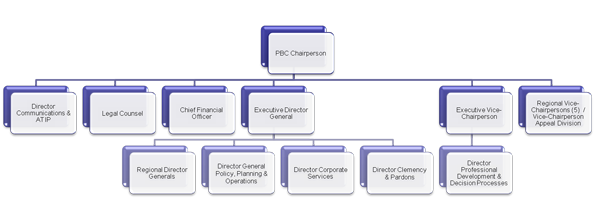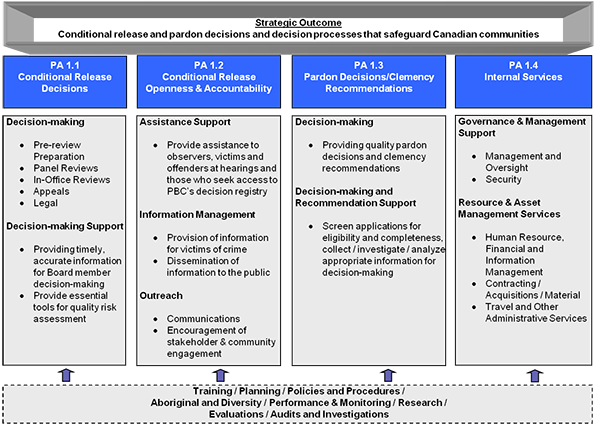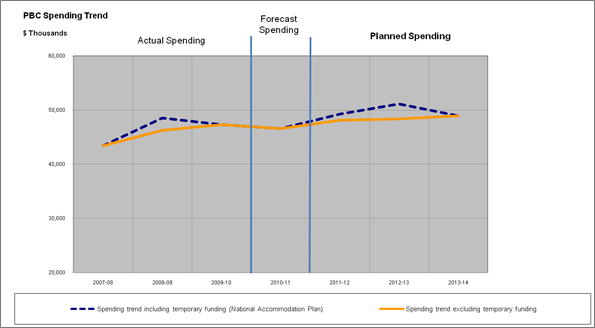Common menu bar links
Breadcrumb Trail
ARCHIVED - Parole Board of Canada - Report
 This page has been archived.
This page has been archived.
Archived Content
Information identified as archived on the Web is for reference, research or recordkeeping purposes. It has not been altered or updated after the date of archiving. Web pages that are archived on the Web are not subject to the Government of Canada Web Standards. As per the Communications Policy of the Government of Canada, you can request alternate formats on the "Contact Us" page.
Chairperson's Message
As Chairperson of the Parole Board of Canada (PBC or “the Board”), I am pleased to present this Report on Plans and Priorities, which outlines the Board’s main areas of focus during 2011-12. Building on a strong foundation of excellence established over its more than 50-year history, the PBC will continue to seek improvements in key areas of its operations and management to ensure that it is both well-positioned and fully equipped to meet its legislated responsibilities in the years ahead.
In developing plans and priorities for 2011-12, the Board's efforts are guided by an enduring commitment to public safety and public service. The Board's identified priorities are fundamental to helping it deliver high-quality conditional release and pardon decisions, deliver an efficient and effective clemency program, enhance openness and accountability and ensure sound administrative practices. These priorities include:
- Effectively fulfilling legislative responsibilities;
- Pursuing strategic excellence in PBC governance;
- Investing in our people;
- Improving information services for victims; and,
- Strengthening stakeholder and community partnerships.
Specifically, the PBC will continue to seek to strengthen its capacity for quality conditional release decision-making to ensure that it responds to recent legislative changes, and the increasingly challenging program environment in which the Board operates – one characterized by a higher percentage of offenders with shorter sentences (i.e., sentences between 2-3 years in length), an increasingly difficult federal offender population (e.g., characterized by longer criminal histories, greater prevalence of violence, more gang affiliations, more serious substance abuse problems and more serious mental health issues), and its growing diversity. Key initiatives to help the Board respond to these challenges include the creation of national standards to ensure consistency in the PBC’s processes, the formal implementation of a Risk Assessment Framework, and enhanced Board member and staff training to ensure the Board remains up-to-date on the latest risk-assessment techniques and emerging issues.
Legislative changes to strengthen the pardon program have resulted in the need for significant operational changes to this program area. The PBC will continue to address these through policy refinement, process streamlining, an increased user fee, and the effective and innovative use of technology.
In keeping with its commitment to openness and accountability, the PBC will continue to proactively engage its criminal justice partners and stakeholders to promote its mandate and ensure the exchange of quality information for use in decision-making. The PBC will also continue to promote its mandate to the public, and work with partners such as the Correctional Service of Canada, to strengthen partnerships with victims' organizations, and improve the provision of information to victims.
Through these plans and priorities, I am confident that the Board has set a course to ensure greater efficiency and effectiveness in the fulfillment of its mandate in the years ahead, and to meet the highest standards of professionalism, quality and efficiency.
_________________________________
Harvey Cenaiko
Chairperson, Parole Board of Canada
Section I - PBC Overview
Raison d'être & Responsibilities
Mandate and Organization
The Parole Board of Canada (PBC or "the Board")[1]is an agency within the Public Safety Portfolio, which also includes the Royal Canadian Mounted Police (RCMP), the Canadian Security Intelligence Service (CSIS), the Canada Border Services Agency (CBSA) and the Correctional Service of Canada (CSC).
The Board is an independent administrative tribunal that has exclusive authority under the Corrections and Conditional Release Act to grant, deny, cancel, terminate or revoke day parole and full parole. The PBC may also order (on referral by CSC) that certain offenders be held in prison until the end of their sentence. This is called detention during the period of statutory release. In addition, the Board makes conditional release decisions for offenders in provinces and territories that do not have their own parole boards. Only the provinces of Ontario and Quebec currently have their own parole boards, which make parole decisions for offenders serving sentences of less than two years.
The Board has extensive legislated responsibilities related to openness and accountability. This includes the provision of information and assistance to victims of crime, observers at hearings, access to the PBC's decision registry, and delivery of a program of public information.
The Board is also responsible for making decisions to grant, deny and revoke pardons under the Criminal Records Act (CRA) and the Criminal Code of Canada. A pardon is a formal attempt to remove the stigma of a criminal record for people who, having been convicted of an offence, have satisfied their sentence as well as a specified waiting period, and remained crime free. The Board also makes recommendations for the exercise of clemency through the Royal Prerogative of Mercy (RPM). The Governor General or the Governor in Council approves the use of the RPM for those convicted for a federal offence, following investigations by the Board, and recommendations from the Minister of Public Safety.
The Parole Board of Canada is headed by a Chairperson who reports to Parliament through the Minister of Public Safety. The Minister, however, does not have statutory authority to give direction to the Chairperson or other members of the PBC in the exercise of their decision-making powers. This structure helps to ensure the impartiality and integrity of the Board's decision making process.
Outcomes of the PBC's daily work can be found in its annual Performance Monitoring Reports (PMR). The PMR provides performance and statistical information for the past five years for the PBC's two legislative based programs - conditional release and clemency and pardons, as well as for the corporate service function of the Board.
Our Mission
The Parole Board of Canada, as part of the criminal justice system, makes independent, quality conditional release and pardon decisions and clemency recommendations. The Board contributes to the protection of society by facilitating, as appropriate, the timely integration of offenders as law-abiding citizens.
As part of the criminal justice system, the Board contributes to the maintenance of a just, peaceful and safe society. The word "contribute" is used in the Board's Mission Statement to reflect the fact that it does not work in isolation in the pursuit of this goal. On the contrary, the Board works in conjunction with Portfolio colleagues, parole boards, police services, after-care agencies, Crown attorneys, defence counsel, and many other organizations and individuals in the community. The legal authority within which the PBC operates is set out by the Constitution, including the Canadian Charter of Rights and Freedoms, the Criminal Code, the Corrections and Conditional Release Act (CCRA) and its Regulations, the Criminal Records Act (CRA) and other legislation.
In making quality conditional release and pardon decisions, as well as clemency recommendations, the Board's primary objective is the long term protection of society. Law-abiding behaviour can best be achieved by timely and supervised conditional release and the effective administration of sentences. During the course of rendering its decisions,the Board is autonomous and independent. However, it is accountable for its actions, by virtue of its guiding legislation, policies and internal framework. The Board is accountable to Parliament and ultimately, to all Canadians.
Achieving the mandate of the PBC is not easily accomplished. It involves the safeguarding of two of PBC's most precious values: public safety and personal freedom. The term "Making the Mission a Reality" is therefore a call to action that becomes the primary responsibility and obligation of all those associated with the Board.
The Mission of the PBC establishes four core values:
- Contributing to the attainment of a just, peaceful and safe society;
- Respect for the inherent potential and dignity of all individuals and the equal rights of all members of society;
- Belief that the contribution of qualified and motivated Board members and staff is essential to promoting the achievement of the Board's Mission; and,
- Commitment to openness, integrity and accountability in the execution of our mandate.
As an agency within the public safety portfolio, the PBC strives constantly to contribute to the government's outcome of a safe and secure Canada. The Board contributes to this outcome by making quality conditional release and pardon decisions that result in the safe reintegration of offenders in the community.
The Board carries out its responsibilities through its national office in Ottawa, as well as five regional offices across the country (Atlantic, Quebec, Ontario, Prairies, and Pacific).
PBC Locations

Conditional release decisions are made by Board members in the regions. Board members are supported in their decision-making by a variety of staff. These staff members schedule hearings, provide information for decision-making, ensure that information for decision-making is shared with offenders, and communicate conditional release decisions to the offender, CSC representatives and others as required. Regional staff also provide information to victims, make arrangements for observers at hearings, and manage requests for access to the Board's decision registry.
At the national office, Board members make decisions related to pardons as well as appeals of conditional release decisions. Staff at the national office deliver the pardons and clemency program; develop conditional release, pardon and clemency policy; coordinate Board member training; and deliver a program of public information. The national office also provides leadership for strategic and operational planning, resource management, performance monitoring, audits and investigations, appeals and an array of internal services.
Consistent with the provisions of the Acts that govern the PBC, Board members are independent in their decision-making responsibilities, and free from outside interference of any kind. As independent decision-makers, Board members are guided by legislation and policy and are responsible for:
- Reviewing all information for consideration in conditional release, pardon and clemency cases;
- Conducting in-depth analysis of each case, and requesting additional information, as necessary, to support quality decision-making;
- Assessing the risk and other factors related to cases, voting independently on the disposition of each case, and providing sound, well-documented, written reasons for decisions; and,
- Ensuring that hearings are conducted in accordance with the duty to act fairly, with respect for all procedural safeguards.
The Chairperson of the PBC is a full-time member of the Board and its chief executive officer. The Chairperson directs PBC's program delivery in keeping with Government of Canada plans and priorities. The Chairperson reports to Parliament through the Minister of Public Safety on the fulfillment of the Board's mandate and is accountable for the effectiveness and efficiency of PBC's policies and operations. The Chairperson is assisted in these responsibilities by the Executive Vice-Chairperson, the Vice-Chairperson of the Appeal Division, and the Board's five regional vice-chairpersons. The Executive Director General of the Board is its senior staff member and chief operating officer. The Executive Director General, in support of the Chairperson, provides leadership for strategic and operational planning, resource management, performance measurement and administration, as well as operation of the national office and the regions.
The following organizational chart provides additional details.
Strategic Outcome and Program Activity Architecture (PAA)
The Parole Board of Canada's Strategic Outcome and Program Activity Architecture (PAA), reflects the key aspects of its legislated responsibilities for conditional release, pardons, and clemency, and it also represents the areas of accountability and performance of greatest public interest. In this context, the Board's strategic outcome is the cornerstone of its public accountability. The PAA includes a single outcome and four program activities.
The following chart illustrates the PBC's complete framework of program activities and program elements, which roll up and contribute to the PBC's single strategic outcome:
Planning Summary
The following tables provide a summary of the PBC's total planned spending and human resources over the next three fiscal years.
The slight increase in financial and human resources is due to a mixture of initiatives such as providing victims with a more effective voice in the justice system and various re-profiling of funds between fiscal years for the Board's medium to long-term accommodation plan for program delivery.
| 2011-12 | 2012-13 | 2013-14 |
|---|---|---|
| 49,235 | 51,174 | 48,913 |
| 2011-12 | 2012-13 | 2013-14 |
|---|---|---|
| 481 | 485 | 485 |
The following table provides a planning summary of the performance indicators and targets for the PBC's strategic outcome. In addition, the table indicates the planned spending for each of the program activities for the next three fiscal years, and aligns the activities to Government of Canada outcomes.
Planning Summary Table
| Strategic Outcome: Conditional release and pardon decisions processes that safeguard Canadian communities | |
|---|---|
| Performance Indicators | Targets |
| The percentage of parole releases in previous years that did not result in a new conviction | Zero (0) re-offending by parolees prior to warrant expiry[2] |
| The percentage of pardon recipients who have not had their pardon revoked | 96% of all pardons awarded remain in force[3] |
| The percentage of victims who express satisfaction with the information and assistance they receive from the PBC | 90% rate of client satisfaction[4] |
| Program Activity[5] | Forecast Spending 2010-11 | Total Planned Spending | Alignment to Government of Canada Outcomes[6] | ||
|---|---|---|---|---|---|
| 2011-12 | 2012-13 | 2013-14 | |||
| Conditional Release Decisions | 34,627 | 36,401 | 38,171 | 35,774 | Safe and secure Canada |
| Conditional Release Openness and Accountability | 5,789 | 6,418 | 6,501 | 6,585 | Safe and secure Canada |
| Pardon Decisions / Clemency Recommendations[7] | 2,780 | 1,218 | 1,218 | 1,218 | Safe and secure Canada |
| Internal Services | 5,230 | 5,198 | 5,284 | 5,336 | |
| Total Planned Spending | 48,426[8] | 49,235 | 51,174 | 48,913 | |
Contributions of Priorities to Strategic Outcome
The following identifies the key operational priorities for the PBC during 2011-12, links them to the Board's strategic outcome and strategic activities, describes why they are a priority, and indicates plans for meeting the priority.
| Operational Priorities | Type | Links to Strategic Outcome(s) | Description |
|---|---|---|---|
| Effectively fulfilling legislative responsibilities related to quality conditional release decision-making | Ongoing |
Strategic Outcome: Program Activity: |
Why a priority:
Plans for meeting the priority:
|
| Effectively fulfilling legislative responsibilities related to open and accountable conditional release processes | Ongoing |
Strategic Outcome: Program Activity: |
Why a priority:
Plans for meeting the priority:
|
| Effectively fulfilling legislative responsibilities related to the processing of pardon applications and clemency requests | Ongoing |
Strategic Outcome: Program Activity: |
Why a priority:
Plans for meeting the priority:
|
| Strengthening stakeholder and community partnerships | Previously committed |
Strategic Outcome: Conditional release and pardon decisions and decision processes that safeguard Canadian communities Program Activity: Conditional release decisions Program Activity: Conditional release openness and accountability |
Why a priority:
Plans for meeting the priority:
|
| Improving information services for victims | Previously committed |
Strategic Outcome: Conditional release and pardon decisions and decision processes that safeguard Canadian communities Program Activity: Conditional release openness and accountability |
Why a priority:
Plans for meeting the priority:
|
The following identifies the key management priorities for the PBC during 2011-12, links them to the Board's strategic outcome and strategic activities, describes why they are a priority, and indicates plans for meeting the priority.
| Management Priorities | Type | Links to Strategic Outcome(s) | Description |
|---|---|---|---|
| Pursuing strategic excellence in PBC governance | Previously committed |
Strategic Outcome: Conditional release and pardon decisions and decision processes that safeguard Canadian communities Program Activity: Conditional release decisions Program Activity: Conditional release openness and accountability Program Activity: Pardon decisions / Clemency recommendations Program Activity: Internal services |
Why a priority:
Plans for meeting the priority:
|
| Investing in our people | Previously committed |
Strategic Outcome: Conditional release and pardon decisions and decision processes that safeguard Canadian communities Program Activity: Conditional release decisions Program Activity: Conditional release openness and accountability Program Activity: Pardon decisions / Clemency recommendations Program Activity: Internal services |
Why a priority:
Plans for meeting the priority:
|
Risk Analysis
The PBC works in a challenging environment that demands effective alignment to the Government of Canada's outcome of a safe and secure Canada, and careful assessment of criminal justice issues and community concerns. The Board is expected to rigorously pursue innovation and improvements to meet heavy workload pressures, with limited resources. Public safety remains the Board's primary concern in all aspects of decision-making policy, training, and operations.
The Board delivers two program areas grounded in legislation: conditional release; and pardons and clemency. The PBC also manages a range of internal services that provide critical support for program delivery. The conditional release area is the most complex and accounts for 87% of annual program expenditures (including conditional release and openness and accountability). Program delivery is labour-intensive, with salary costs accounting for approximately 80% of yearly program expenditures. Most of the remaining expenditures cover essential operating costs, such as travel to parole hearings. In this context, management of heavy and complex workloads within existing budgets, consistent with the principle of contributing to public safety, presents a constant challenge.
Conditional Release
The PBC workloads are shaped by factors beyond its control. Legislation governing the Board (the Corrections and Conditional Release Act - CCRA) is prescriptive, specifying when and how the Board conducts its business (e.g., when to hold reviews). In addition, workloads are driven by the actions of offenders, victims and the community. In concrete terms, this means that the PBC must deal with high workload volumes, involving critical issues of public safety, under tight timeframes, amid intense public scrutiny. For example, in 2011-12 the PBC expects to complete over 17,000 conditional release reviews for federal and provincial/territorial offenders.
The Board must also continue to deal with the ever growing complexity in conditional release decision-making, as reflected in three important trends. The first is the more difficult federal offender population, characterized by longer criminal histories, greater prevalence of violence, more gang affiliations, more serious substance abuse problems and more serious mental health issues. The second involves the shift toward shorter federal prison sentences. A more difficult offender population with shorter sentences (and less time to benefit from programs) challenges the PBC's work to assess factors related to safe reintegration into the community. The third trend is the growing diversity in the offender population, as reflected in the continued over-representation of Aboriginal people and the growing numbers of offenders from diverse ethno-racial communities. This trend requires that the Board continue to ensure policies, training and decision processes are reflective of present and future realities. Doing so will enable the Board to collect and assess relevant information related to risk and safe community reintegration for groups of offenders with unique needs and circumstances. Decision processes such as Elder-assisted hearings for Aboriginal offenders exemplify the PBC's efforts in this area.
The openness and accountability provisions of the CCRA continue to present important challenges for the Board with respect to:
- Sharing information with victims of crime;
- Providing of information and assistance to those who wish to observe PBC hearings or gain access to the Board's registry of decisions; and,
- Delivering a program of public information.
Workloads in these areas have grown exponentially since the introduction of the CCRA in 1992. In 2011-12 for example, the Board expects to have approximately 20,000 contacts with victims, over 2,200 observers at hearing and process about 6,000 requests for access to the decision registry. As with conditional release decision-making, the need for quality program delivery in this area is critical, given its implications for public safety and public confidence in corrections and conditional release. Ongoing public scrutiny and media interest in this area make program effectiveness crucial.
The Government has announced extensive plans to tackle crime and strengthen community safety, including measures for reform of sentencing, corrections and conditional release. Effective support for these measures continues to be a focal point for the Board. The Board must manage the workload and cost implications of legislative amendments to include mandatory minimum penalties for gun crimes and drug offences, address time spent in pre-sentence custody, and proposed amendments to the CCRA. These amendments are lengthening periods of incarceration for offenders. Longer sentences are increasing PBC workloads and costs for conditional release reviews, contacts with victims of crime, etc.
Pardons and Clemency
Recent legislative amendments to the Criminal Records Act (CRA) have led to process changes within the pardon program.
On June 29, 2010, Bill C-23A came into force, amending the CRA to:
- Increase the ineligibility period for a pardon for certain offences;
- Ensure that the Board has the authority to make inquiries with regard to pardon applications for all types of offences;
- Ensure that the Board has the discretion to consider additional factors in the decision-making process for pardons;
- Establish factors the Board may consider in determining whether the granting of the pardon would bring the administration of justice into disrepute; and,
- Implement the assessment of good conduct in all cases.
Pardon program operations have changed significantly due to legislative changes. As a result, Board staff are required to obtain additional information from applicants, research and investigate cases including more in-depth inquiries with criminal justice partners, build files, and provide the information to Board members. In addition, Board members require additional time to review cases and to make decisions based on the merits of each case.
Additionally, the eligibility period for certain offences has been lengthened by the amendments to the CRA. This has implications for the Board's Clemency unit. In past years the Clemency Unit typically handled approximately 20 applications a year. Currently, the Unit is managing in excess of 50 active files and dealing with an increase in inquiries as a consequence of the new legislation, causing delays in processing applications for the Royal Prerogative of Mercy (RPM).
In order to ensure the program can continue to be delivered effectively without affecting budgets devoted to the Board's conditional release program, the Board is seeking to implement a full-cost recovery model for the processing of a pardon application.
Strategic Resource Management
The Board must continue to address the need for strategic management of human, financial, information and technology resources to support quality program delivery. The PBC is committed to ensuring a strong, diverse and dynamic workforce that excels in delivering the Board's mandate to Canadians, today and in the years to come.
The Board's human resource challenge has two dimensions:
- Maintaining sufficient numbers of experienced Board members is an ongoing challenge because of their specified periods of appointment; and,
- Over the next few years, many senior and experienced staff at the Board will be able to retire without penalty to their pension.
The first challenge involves Board members who are Governor-in-Council appointments. The CCRA specifies that the Board will comprise no more than 45 full-time members. The Act also provides for the appointment of part-time members to help manage conditional release decision-making workloads. Board members are usually appointed for three-year terms. Each year, decision-making workloads require the use of significant numbers of part-time Board members (over the last five years the number has increased from 15 to 25 full-time equivalents). Maintaining sufficient numbers of experienced Board members is a challenge because of the specified terms of appointment. The PBC must also deal with the reality that, following an initial orientation period of five weeks, newly appointed Board members still require three to six months of additional training and mentoring before they can manage the full scope of their decision-making responsibilities. In this context, the Board must ensure that it recruits sufficient numbers of qualified candidates for consideration for appointment as Board members, and provide effective training to ensure that Board members have the knowledge they need to apply PBC policies and assess risk in decision-making.
The Board faces another challenge with respect to succession planning with regard to its public service staff. Departures of experienced staff erode corporate memory and diminish critical knowledge of the law, policy, and training. The impact of this is especially acute in a small organization. Board staff provide the continuity of knowledge and information essential for quality program delivery. For this reason, development of an effective human resource plan for dealing with staff turnover is essential.
Timely access to relevant information provides the foundation for quality conditional release and pardon decision-making and ultimately for the Board's continuing contribution to public safety. In addition, the Board must deal with legislated responsibilities for sharing appropriate information with victims of crime, offenders, other criminal justice agencies, and the public. In this environment, strategic information management is crucial, requiring the Board to have the automated systems necessary to support effective collection, storage and sharing of information. Additionally the Board must have in place the policies and procedures necessary to ensure effective information management. Progress in these areas will require the assistance of the Correctional Service of Canada (CSC) as it is the Board's information technology service provider. Effective management of this partnership for service delivery must continue to be a priority for the Board.
Strategic management of financial resources will also present important challenges. For the foreseeable future, the Board will face complex and growing workload pressures in areas of legislated responsibility. There is also a growing need for resources to address Treasury Board Sexretariat and Public Safety Canada monitoring and accountability mechanisms. The Board's limited resource capacity could be further constrained by the need to address new priorities in a period of restraint in which the focus of the federal government will be on efforts to stimulate economic recovery.
Expenditure Profile
For the 2011-12 fiscal year, the PBC plans to spend $49.2 million to meet the expected results of its program activities and contribute to its strategic outcome. The figure below illustrates the PBC's spending trend from 2007-08 to 2013-14. The figure also illustrates spending as a result of temporary funding received for medium to long term accommodation refits in-line with the PBC's National Accommodation Plan (NAP).
The increase in the spending for 2012-13 is due to temporary funding received for tenant accommodation refits in-line with the NAP.
Note: 2010-11 "Forecast Spending" of $48.4M is based on PBC's November forecast.
The figure below displays the allocation of PBC planned spending by program activity for 2011-12.
($ thousands)

[Text equivalent]
Almost three-quarters (74%) of the PBC's funding is allocated to Program Activity 1.1 (conditional release decisions), and 13% is allocated to Program Activity 1.2 (conditional release openness and accountability). In total, the Board's work relating to conditional release accounts for 87% of annual program expenditures. An additional 2% is dedicated to Program Activity 1.3 (pardon decisions/clemency recommendations), and the remaining 11% is dedicated to Program Activity 1.4 (internal services).
Estimates by Vote
For information on our organizational votes and/or statutory expenditures, please see the 2011–12 Main Estimates publication. An electronic version of the Main Estimates is available at http://www.tbs-sct.gc.ca/est-pre/20112012/me-bpd/toc-tdm-eng.asp.



